'Pharmacy deserts' are new front in the race to vaccinate for COVID-19
Jorge Figueroa was willing to drive eight hours round trip.
He wasn't going on vacation or to visit a relative.
Instead, he was planning to get a lifesaving shot to protect him from COVID-19 -- a shot that many Americans can now conveniently access at their neighborhood pharmacy.
The 54-year-old father of four has been eager to get vaccinated because he has high blood pressure, which could increase his risk of severe illness from the coronavirus. But Figueroa lives in Presidio, Texas, a city of about 4,000 people on the U.S.-Mexico border where there's no hospital, no full-time doctor and no pharmacy.
It's an issue that millions of Americans also face.
After scouring social media for pop-up vaccine events and putting his name on waiting lists at local clinics, he eyed a vaccine hub in Odessa, some four hours away. But without a guaranteed appointment, an eight-hour drive and the possibility that he'd wait in line for hours, it was too big of a commitment for a risky trip from which he could come back empty handed.
On Saturday, his luck turned. After weeks of desperate searching, multiple follow-up calls with providers, and a last-minute scramble for an open spot, Figueroa got an appointment and his first shot at a clinic in Presidio that day.

With coronavirus deaths topping the grim 500,000 milestone in recent days and the case count inching towards the 30 million mark, many Americans are eagerly hoping the vaccines can bring some normalcy back to their lives.
Since vaccination began in mid-December, nearly 110 million doses have been delivered to various providers across the nation -- starting with big hospitals and local health centers and now expanding into mass vaccine hubs and big and small pharmacies.
Nearly 83 million of the doses have been put into people's arms so far.
But many health experts and community leaders worry about equity in access when the vaccination program expands to the wider public later this year because of disparities in the existing health care infrastructure and location of drugstores in underserved neighborhoods.
Even though 90% of Americans live within 3 miles of chain pharmacies, there are many others who live in so-called food and health care deserts, without a single grocery store or pharmacy in close range, said Dr. James Hildreth, president and CEO of Meharry Medical College and a member of Biden's COVID-19 Health Equity Task Force.
According to ABC News' analysis of pharmacy locations across the country, there are 150 counties where there is no pharmacy, and nearly 4.8 million people live in a county where there's only one pharmacy for every 10,000 residents or more.
Based on Census data, there are far fewer pharmacies per person -- especially chain pharmacies -- in rural parts of the country compared to in urban areas, especially in Southern and Plains states.
The drugstore disparity is particularly significant in majority-nonwhite rural neighborhoods, where there is on average one pharmacy per 9,888 people, compared to one pharmacy per 8,045 people in whiter rural neighborhoods.
The racial gap exists throughout the country, including in urban areas, where there are more pharmacies in whiter and wealthier neighborhoods per person than in poorer, predominantly nonwhite neighborhoods.
This means that residents in rural communities could have fewer options to get shots as the country moves to vaccinate the general public, health experts say, while pharmacies in underserved urban communities are set to be more crowded and inaccessible as they are expected to serve a far bigger population.
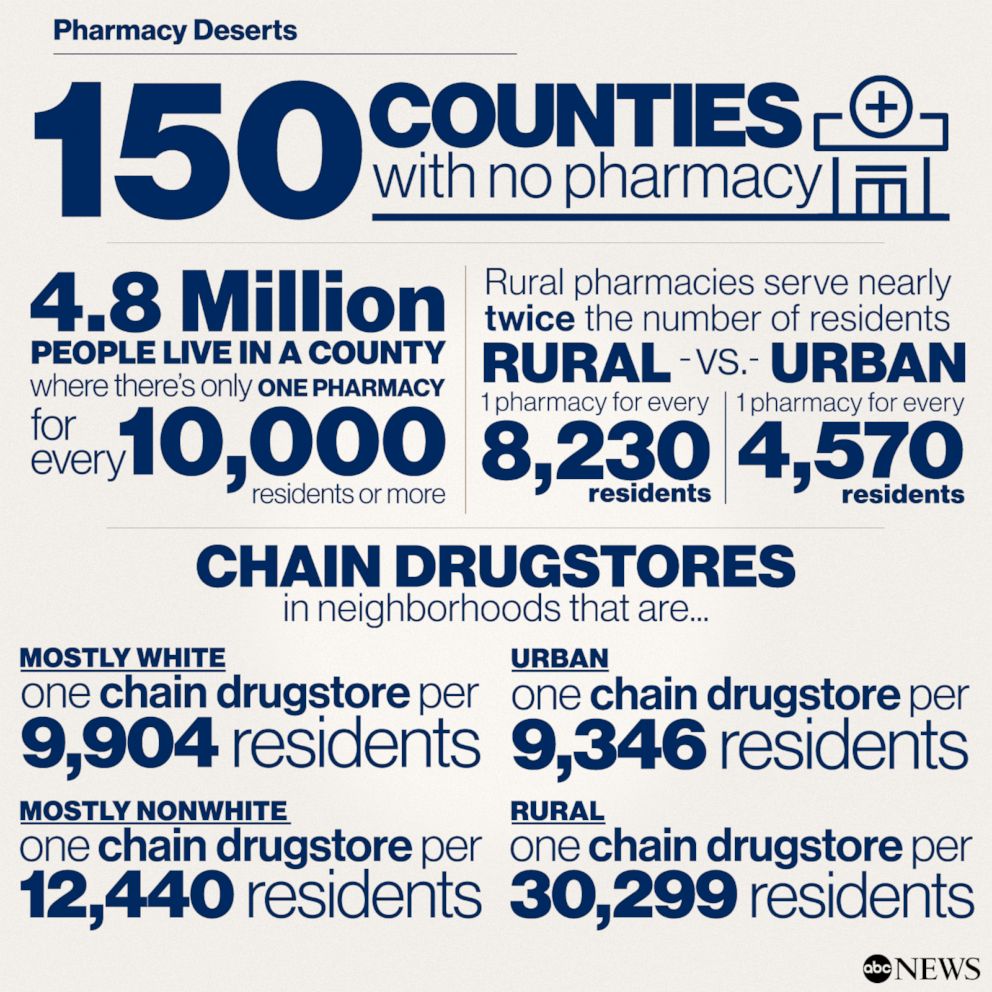
When ABC News asked major chain pharmacies about their plans to help ensure underserved communities had equal access to the vaccine, Walgreens pointed to a pilot program with Uber rolling out in coming months, which will offer free or discounted rides for vaccinations in cities like Chicago, Atlanta, Houston and El Paso.
CVS's partnerships with Lyft and nonprofit organizations like the YMCA will similarly offer free or discounted rides.
President Joe Biden has described equity in vaccine distribution as the "No. 1" priority for his administration. He has emphasized that millions of doses have been directed to community health centers specifically to target vulnerable populations, and boasted the federal government's partnership with more than 6,700 pharmacies across the country, saying "almost everyone" lives within the reach of a pharmacy. He also committed to providing mobile units to go into neighborhoods that are hard to get to.
But partnering with pharmacies isn't enough to ensure equal access to vaccines, experts say.
"While pharmacies represent a critical resource in communities for preventative care services including vaccines, their distribution is based on economic factors rather than population representativeness," said Dr. John Brownstein, an epidemiologist at Boston Children's Hospital and ABC News contributor.
"In order to ensure equitable distribution of vaccines, the rollout needs to ensure that geographic accessibility is not a barrier to access especially for those who would benefit the most," Brownstein said.
Rural areas 'need more help'
In Texas, more than two dozen of the state's 254 counties have no pharmacy at all, two of them -- Hudspeth and Culberson counties -- located in the vastly rural western border region between urban El Paso and Odessa, described by some as "miles and miles of nothing."
"It's almost desert-type climate and an interstate highway running through it, but not a lot of people and certainly not a lot of health care services," said John Henderson, the CEO and president of the Texas Organization of Rural and Community Hospitals, who coordinates allocation of doses in rural vaccine hubs in the state.
Just south of Hudspeth and Culberson counties is the city of Presidio, where Figueroa lives. The closest pharmacy is in Marfa, an hour drive away, and to find pharmacies that are equipped to vaccinate people one would have to drive further up to Alpine, in Brewster County, which is about an hour and a half away.
Figueroa, who lost his health insurance when he got laid off as a construction worker in August as the coronavirus was raging in the South, has been making four-hour trips across the border to Mexico to find cheaper health care and medicine when he has needed to seek medical attention.
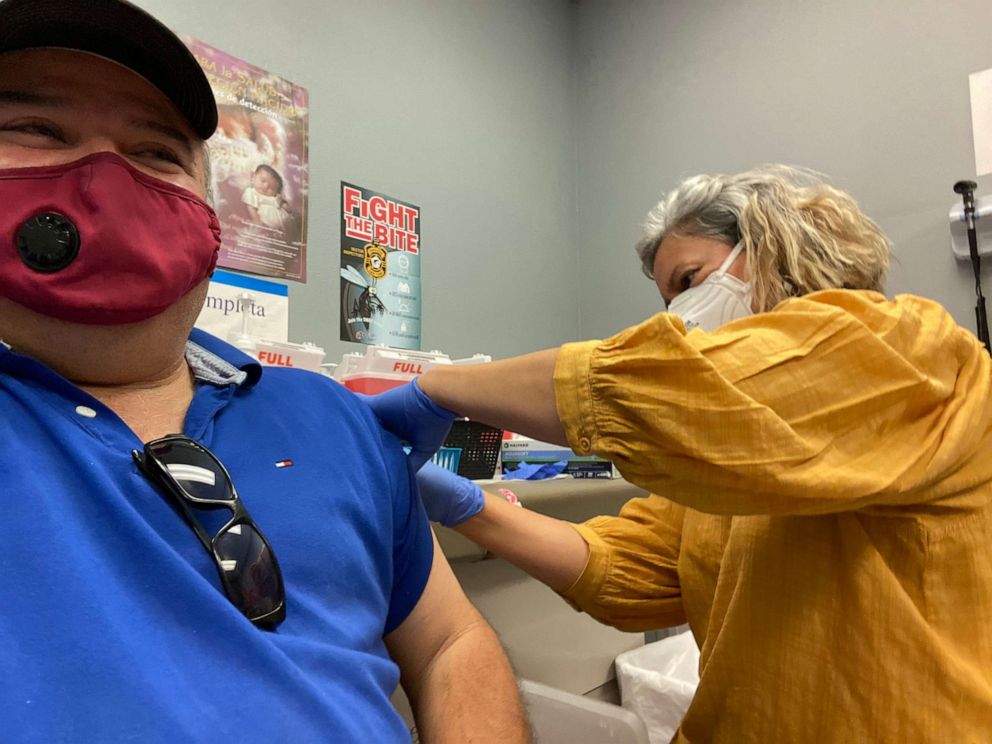
There are local clinics and health centers in Presidio, Marfa and Alpine that have been vaccinating community members, but supplies have been limited.
Without existing relationships with local clinics and pharmacies -- which help them be aware of his medical conditions -- Figueroa said the process of trying to get on various vaccine waitlists with local providers was "frustrating."
For weeks, his numerous efforts to find a slot at local clinics in Presidio and Marfa didn't materialize, and Figueroa said he was "this close" to driving to a vaccine hub in Odessa over the weekend, until on Friday he finally managed to get an appointment for the following day at a local community clinic in Presidio.
Alan Morgan, CEO of the Rural Health Association, worries about rural communities like Presidio, as states turn to mass vaccination sites to ramp up distribution.
"You have an easy solution of just setting up these massive vaccination sites in urban areas," Morgan said. "We're going to have a huge health disparity as we move forward."
The Federal Emergency Management Agency (FEMA) is opening five new mass vaccination centers in New York and Texas, with military medical teams providing the jabs.
The efforts will be centered around major cities, with a site at the NRG Center in Houston expected to be able to vaccinate 6,000 people a day, and the Fair Park Cotton Bowl Stadium and the AT&T Stadium and Globe Life Park in the Dallas area able to vaccinate 3,000 people a day.
But Presidio has none of that, and health care providers like Dr. Adrian Billings, 49, are doing their best to bridge the gap.
Billings is one of four doctors who makes the 90-mile drive from Alpine to Presidio to work at its community health center, a safety-net clinic for patients, most of whom are poor and primarily speak Spanish. Many are uninsured and don't have reliable cars. They walk to the clinic for care.
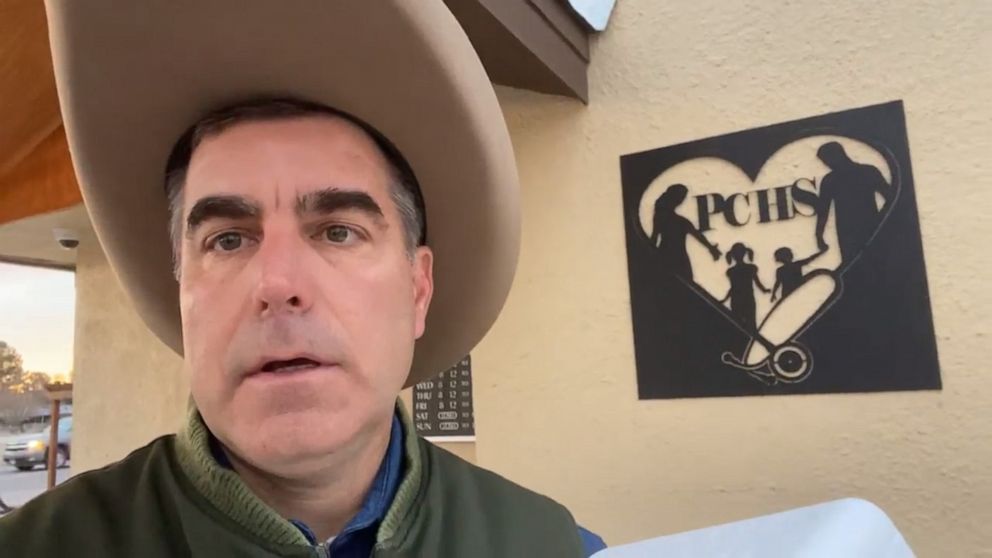
When vaccine doses arrive for Presidio from Alpine, often without more than a few hours notice, Billings said his team -- which services three different clinics in the region -- scrambles to call patients to schedule appointments.
Doses have to be kept cold for the hour and a half drive through the desert.
Billings said there's not enough staff to give vaccines and provide medical care simultaneously, so the clinic has to triage, and shuts down non-emergency medical services on days when they administer vaccines.
"I wish it was easier," Billings said.
He's still holding out hope that the National Guard takes over Presidio's vaccination effort, allowing the doctors to go back to treating patients. Then, they wouldn't have to choose between offering medical care and giving vaccines.
"We're doing the best we can, but we need more help," he said.
Linda Molinar, whose community clinics in Presidio, Marfa and Alpine have had to cut regular medical care services to vaccinate people, asked the question: "Who's taking care of the sick people?"
"Do I do vaccines, or do I see these people that are needing their insulin?" Molinar said. "I have people right now that are supposed to get allergy shots every other day, and we're the only clinic that does this. Where are they supposed to go?"
"COVID just made everything harder," Molinar added.
'Messy' and 'uneven'
Vaccine allocation in rural Texas has at times been "messy" and "uneven," Henderson of TORCH said.
At the beginning of January, 40% of rural hospitals still had not received a single dose for their front-line health care workers, he said, and finally, six weeks into vaccination, every rural hospital in Texas had received doses.
For Presidio and Marfa, Midland Memorial Hospital -- one of the closest vaccine hubs in the area -- has stepped up to share vaccine doses with those cities and to bring vaccines to the communities.
Doses are finally trickling down to smaller providers in rural towns.
In Marfa, the local health center has been receiving a weekly allocation of 500 doses since February. In Alpine, local drugstore Prescription Shop received 100 doses through the Federal Retail Pharmacy Program just before a snowstorm hit the state last month.
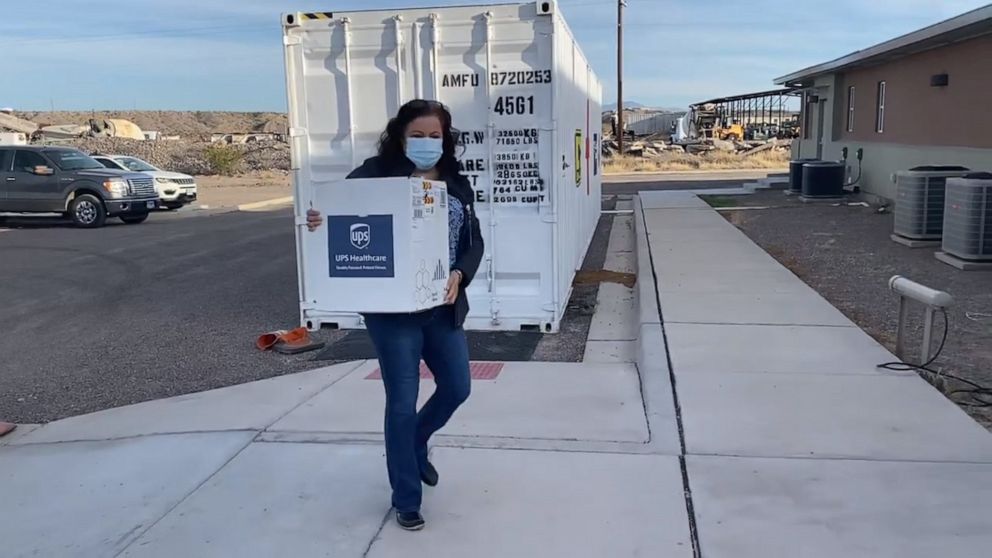
Highland Drug, another local pharmacy in Alpine, was recently offered 1,100 doses of the Pfizer vaccine, but had to decline and wait for fewer doses of the Moderna vaccine because the store didn't have the ultra-freeze capability required for the Pfizer vaccine.
The store also didn't have the capacity to vaccinate that many people before the doses would expire, the pharmacy's owner and pharmacist Jill Jahn told ABC News.
Jahn, whose store serves patients from about 100 miles in every direction, including from Presidio and Marfa, said once her pharmacy receives vaccines, it will be open on weekends to vaccinate people in the community. She said she even plans to bring vaccines to her patients' homes in case they can't get to her pharmacy.
Presidio County has so far fully vaccinated a much higher percentage of its residents over the age of 16 than Dallas County or Harris County, according to data released by the state.
But Bob Fast, the owner and pharmacist at Prescription Shop in Marfa, said that he's more "anxious" about vaccinating the general public in the coming weeks and months.
"When that happens, that's going to be a lot of people," Fast said. "I don't know whether there's going to be more of a challenge, but there's going to be some uncertainty in the supply."

Keith Mueller, the director of the Center for Rural Health Policy Analysis at the University of Iowa, who has studied distribution of pharmacy locations across the country, said pharmacy closures over the years, exacerbated by the pandemic in the past year, have contributed to the spread of vaccine deserts across the country.
From 2010 to 2016 the number of independent pharmacies was on the rise, but a recent report by the Pharmaceutical Care Management Association says that between 2016 and 2019, there was a net loss of 83 independent pharmacies across the country (roughly 0.3% of all independent pharmacies) and a net loss of 1,583 chain stores (roughly 4% of chain stores).
In addition to Texas, states like Nebraska and Montana, which also have clusters of counties without pharmacies, could be especially vulnerable, Mueller said.
In northwest Nebraska, there are eight adjoining sparsely-populated rural counties where COVID-19 infection rates average 6,400 per 100,000 residents and there are at least nine deaths as of March 1. But not a pharmacy is in sight for vaccine shots in these counties.
According to vaccine location data, there's one vaccine provider registered in each of these eight counties, but state-released data suggests that these are satellite sites that will get limited, redistributed doses from vaccine hubs that are equipped with ultra-cold freezers and dry ice suppliers.
This means that many of Grant County's 700 residents -- in one of those vaccine desert counties -- will be forced to make at least an hour's drive to the nearest drugstore taking COVID-19 vaccination appointments -- a Safeway Pharmacy in Ogallala, a town in neighboring Keith County which was a one-time mail stop on the legendary Pony Express.
Disparities in cities, too
While urban areas have more pharmacies than their rural counterparts, there are stark racial and wealth disparities in terms of access.
In places like Chicago and Detroit, a pharmacy desert doesn't mean that residents have to drive an hour to find the nearest drug store, rather, it means that there are fewer available. This means pharmacies are slammed with serving more people and residents face longer wait times and other challenges, like transportation barriers.
Similar access disparities were found in Detroit and Chicago, even when taking other vaccine sites, like local clinics and health centers, into consideration.
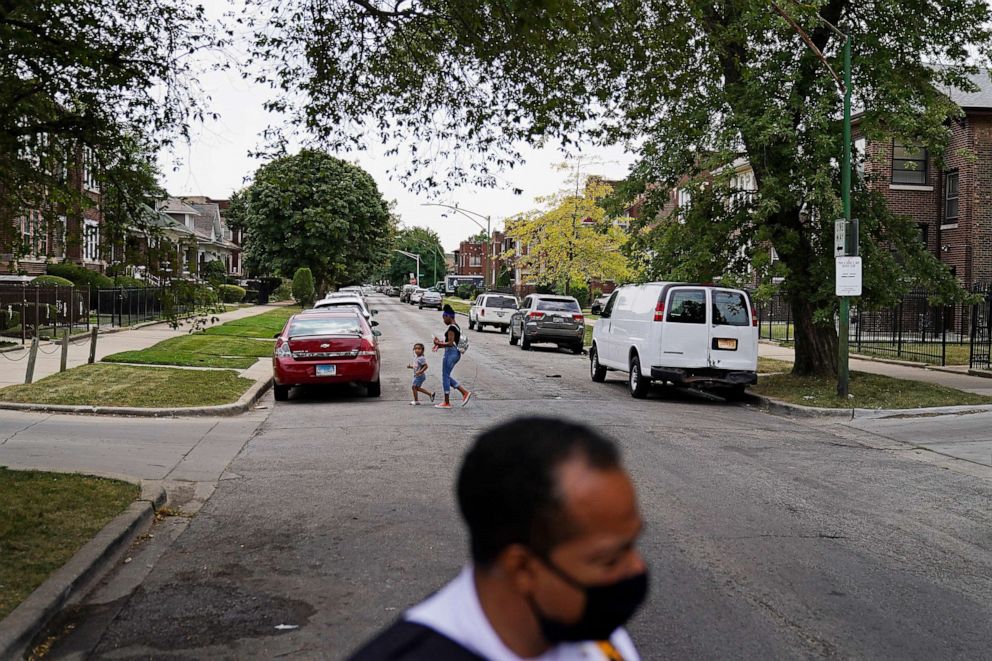
In Chicago, at least a third of the population -- or nearly 1 million people -- lives in a pharmacy desert, or an area with less than one pharmacy per 10,000 residents, according to Dima Mazen Qato, an associate professor at the University of Southern California School of Pharmacy. Most of those pharmacy deserts are in Black and brown communities.
While there are 254 pharmacies on the city's wealthier, slightly less populated North Side, for example, the poorer South Side only has 141, according to pharmacy location data.
Juanita Love, 80, has lived in Auburn Gresham, a neighborhood on the South Side, for 50 years. There used to be a CVS pharmacy three blocks away, she said, which she could easily walk to.
When the local CVS shut, getting medication became a challenge for Love's older neighbors, for many of whom hopping on a public transportation to get to a pharmacy far away isn't always an easy option. "My neighbors don't have cars, a lot of them don't drive," Love said. "It's really difficult for them."
There's only one pharmacy for every 13,541 residents in the Auburn Gresham neighborhood, where 95% of the residents is black and the median household income is $36,767.
In comparison, the Ukrainian Village, the Wicker Park and the East Village neighborhoods, where majority of the residents are non-Hispanic white, and the median household income is nearly three times that of Auburn Gresham's, there's one pharmacy per just 4,441 residents.

To fill their prescriptions, Love's neighbors have leaned on family members, called Ubers and gotten help from the neighborhood block club. But even with help, those barriers still exist, and with very few pharmacies in the area, they're facing many hurdles to get vaccinated for COVID-19.
As of last week, 3.2% of the residents in Love's ZIP code were fully vaccinated, and 8.2% got their first shot, according to city data. In the wealthier, whiter Ukrainian Village/Wicker Park area, 9.3%, were fully vaccinated, and 16.6% got their first shot.
Love has a car, so she drove 15 minutes to another pharmacy for her first dose earlier this month. It's different without a neighborhood drug store, she explained. Seniors felt unaided and upset when their CVS shut down.
"It was convenient to us all," Love said.
'Shoe leather' efforts to get people vaccinated
Dr. Ali Khan, the executive medical director at Oak Street Health in Chicago, said at a macro level, there's a "perverse logic" in how the early vaccine distribution effort has played out so far. He said much of the early resources have gone to major institutions concentrated in wealthier, whiter parts of the city, when underserved communities were the ones hit harder by the pandemic.
So Khan's facility has partnered with the city of Chicago to actively bring vaccines to underserved communities, relying not just on online registration to reach people but also through "shoe leather" efforts like knocking on doors and engaging with community organizations such as faith-based organizations or housing access organizations.
In Detroit, where data shows fewer pharmacies serve larger populations in predominantly black neighborhoods compared to in whiter neighborhoods, the city is taking a similar approach.
In addition to a mass vaccination site at a convention center downtown, the Detroit Health Department has partnered with two of the city's largest churches, Fellowship Chapel and Second Ebenezer, to hold weekly "Senior Saturday" events to vaccinate up to 500 Detroit residents 65 years old or older -- an effort to directly infuse vaccines into communities most impacted by the pandemic.
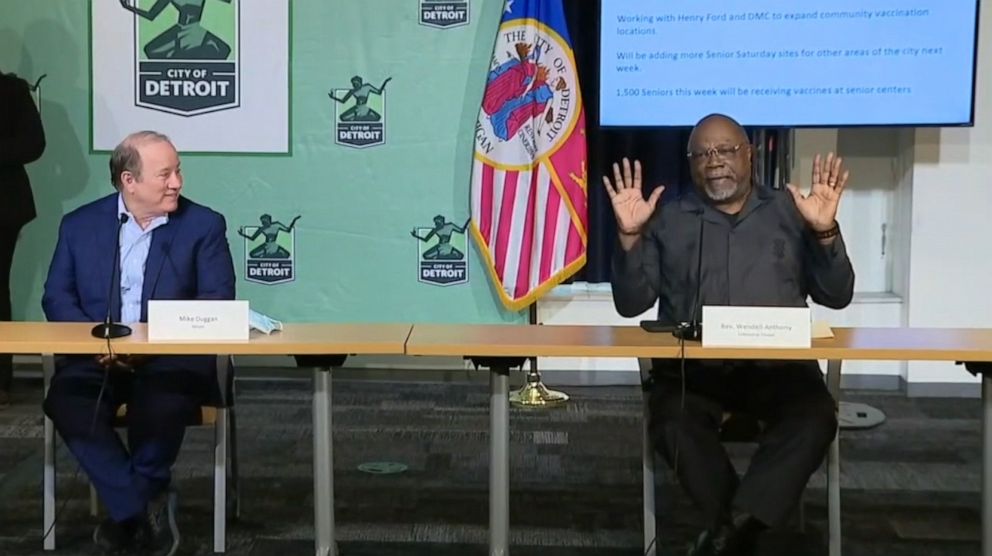
"There are trusted community voices, trusted community partners that can be very well utilized in helping to attack vaccine hesitancy and provide a foundation of trust for those in the community and greater accessibility also for community residents," said Bishop Edgard Vann of the Second Ebenezer Church.
"The key word is 'trust,' not 'vaccine,'" said Bishop Vann, who also sits on the executive board of the Henry Ford Health System, which works with the city and the church to organize the "Senior Saturday" events.
Pamela Wilson, 61, shared that spirit when she took her 83-year-old mother to get vaccinated at the Second Ebenezer Church last month. She said she had the option of taking her mother to a different vaccine site further down in the city, but chose the church site for "extra blessing."
But the Detroit resident-exclusive vaccination opportunity at local churches was not available to Geri Withers, a 77-year-old resident of the township of Canton, just outside of Detroit. Withers had called, texted and emailed numerous big-chain pharmacies close to her home, but she ended up making a 30-minute trip to get vaccinated at a Meijier store in Southgate.
Hildreth said it's time to identify and empower trusted community messengers to reach the public.
"There are organizations that have the capacity, that are trusted to get this done, but we've never felt empowered to do so," Hildreth said. "And I think that's one thing that needs to be done -- to recognize other assets and bring all the assets to bear on the problem. We haven't yet done that. We need to do that."
ABC News' Ashley Louszko and Laura Coburn, and Boston Children's Hospital's Benjamin Rader contributed to this report.
Editor's Note: This story has been updated.




